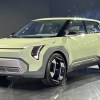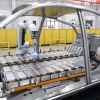
What Is Instant Torque, and How Does It Work in Electric Cars?
Saying EVs are astonishingly quick is an understatement. Models like the Tesla Model S Plaid can easily accelerate from 0 to 60 in under 2 seconds in the right circumstances. This puts them in league with some of the most expensive and powerful supercars. However, the driving force behind the electric cars’ stunningly quick acceleration is instant torque, something that fuel-powered supercars don’t have.
But what is instant torque, how does it work, and why do electric cars have it while their fuel-powered counterparts don’t. Answering these questions would be tricky without first explaining what torque is, how it’s measured, and why it’s essential in cars.
What is torque

A simple explanation of torque is it’s a twisting force. You can see examples of torque in everyday life, such as when you’re opening a door or tightening bolts. In these examples, you apply a twisting force either to the door handle or to the bolt by using a wrench.
Torque is measured in pounds-feet (lb-ft), and in an engine, the twisting force or torque is necessary for rotating the crankshaft continuously. The torque is then transferred to the vehicle’s wheels, allowing them to handle hard work like going uphill, taking on rough terrain, and towing trailers.
It’s even necessary for propelling the vehicle forward from a standstill. As such, it’s no surprise that the Rimac Nevera, an EV with 1741 lb-ft of torque according to MotorTrend, also has one of the fastest acceleration speeds in the market. Rimac claims the electric hypercar can go from 0 to 60 in 1.85 seconds.
How peak torque is achieved in fuel-powered vs. electric cars with instant torque
With fuel-powered cars, the maximum twisting force or peak torque can only be achieved at certain engine RPMs, differing from model to model. For instance, the peak torque for the 2022 Dodge Charger SRT Hellcat Redeye Widebody is 797 lb-ft at 6300 RPM.
For context, engine revolutions per minute (RPM) measure how fast the engine is operating at any given time.
It’s worth noting that the torque will either increase or decrease if the car isn’t at the designated engine speed. Also, if your vehicle is starting at a low RPM, reaching the required engine speed for maximum torque takes some time.
Conversely, maximum torque in electric vehicles is achieved the moment you floor the throttle, hence instant torque. According to Car Throttle, this is primarily because there is little to no back electromotive force (EMF) in the electric motor powering the car’s wheels.
Back EMF is a counter electromotive force that increases in an electric motor the faster it rotates. Unfortunately, back EMF also reduces the working voltage of the car, which in turn cuts down the power reaching the car’s wheels. Working voltage is typically the result of the supply voltage minus back electromotive force.
To put this into perspective, if you supply 120V of power to a motor and the back EMF is 90V, you only have a working voltage of 30V. Conversely, if the engine isn’t rotating, there’s no back EMF meaning the full 120V of power can be used to create torque.
Since the electric motors are barely spinning before you start driving, there’s little to no back EMF, and consequently, EVs always seem to be faster off the line. However, the motors will rotate faster once you’re driving; therefore, back EMF is bound to build up.
This creates problems at the top end, so electric cars have trouble accelerating past a certain point, like around 150 mph plus.
Other reasons why electric cars are so quick off the line
There are also other reasons why EVs like the Lucid Air Dream Edition may beat powerhouses like the McLaren Senna to the 1/4-mile mark in a drag race. One is the positioning of the motors, with most EV manufacturers placing them at both the front and rear wheels. The result is extra traction, meaning minimal to no wheel spin once you floor the throttle.
Additionally, electric vehicles feature only one gear compared to the multi-speed gearbox of fuel-powered cars. Consequently, you don’t have to wait for a multi-gear downshift before the motor’s power can be delivered to the wheels. This makes the cars more responsive to the throttle.


